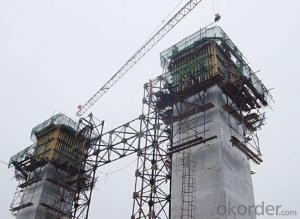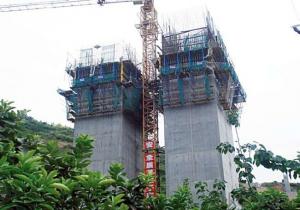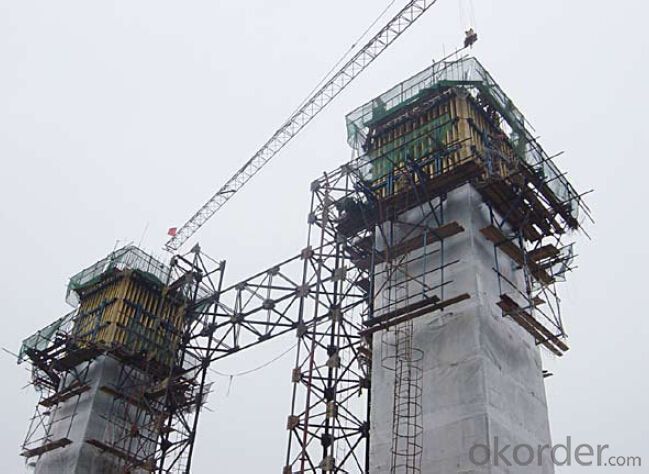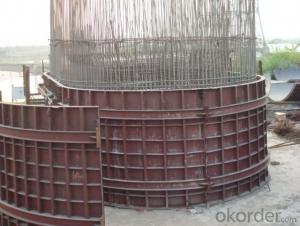Climbing Bracket for formwork and scaffolding systems
- Loading Port:
- Tianjin
- Payment Terms:
- TT OR LC
- Min Order Qty:
- 50 m²
- Supply Capability:
- 1000 m²/month
OKorder Service Pledge
OKorder Financial Service
You Might Also Like
Climbing Bracket CB240 & CB210
They are framework brackets for supporting large-area wall formwork.
Typical applications for the CB240&CB210 are pier and column/shear wall/core walll/ in the
building.
CB210 has smaller size than CB240, it will be cost effective in some condition.
Characteristics:
◆ High bearing capacity
The high loading capacity of the brackets allow very large scaffold units. This saves the number
anchor points required as well as reducing climbing times.
◆ Simple moving procedure by crane
Through the strong connection of formwork together with the climbing scaffold, both can be moved
as a single climbing unit by crane. Thus valuable time-savings can be achieved.
◆ Fast striking process without a crane
With the retrusive set, large formwork elements can also be retracted quickly and a minimum of
effort.
◆ Safe with work platform
The platforms have assembled firmly with bracket and will be climbing together, without scaffolding
but can work safely in spite of your high location.
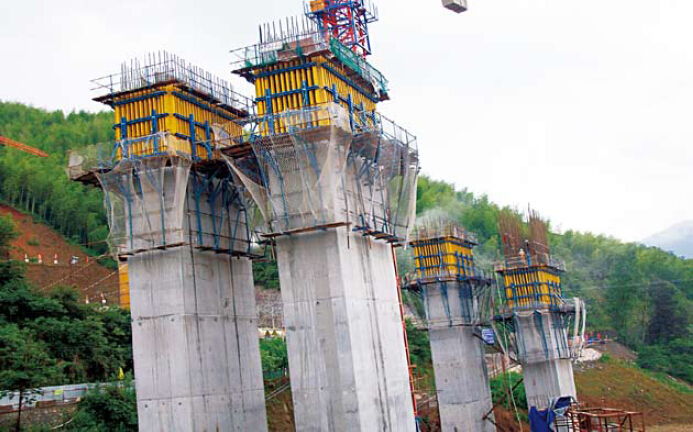

- Q: What are the different types of reinforcement used in steel formwork systems?
- There are several types of reinforcement commonly used in steel formwork systems, including steel bars, mesh, and fibers. Steel bars, also known as rebars, are often used to provide structural strength and support within the formwork. Steel mesh, on the other hand, is typically used to distribute loads evenly and prevent cracking. Lastly, steel fibers can be added to the concrete mix to enhance its tensile strength and improve resistance to cracking and shrinkage.
- Q: What are the different surface finishes available for steel formwork?
- There are several surface finishes available for steel formwork, including smooth, textured, and coated finishes. Smooth finishes provide a sleek and polished appearance, while textured finishes create a rougher surface for enhanced grip and adhesion. Coated finishes, such as epoxy or galvanized coatings, offer additional protection against corrosion and wear.
- Q: How does steel formwork handle different concrete expansion properties?
- Steel formwork is a highly durable and rigid material that can easily handle different concrete expansion properties. Its strength and stiffness allow it to withstand the pressure exerted by expanding concrete without deforming or cracking. Additionally, steel formwork is typically designed with expansion joints or gaps, which provide sufficient space for the concrete to expand and contract without causing any structural issues. This ensures that the formwork remains intact and maintains its shape, allowing for successful concrete pouring and curing.
- Q: How does steel formwork perform in high-temperature conditions?
- Due to its innate strength and heat resistance properties, steel formwork performs exceptionally well in high-temperature conditions. With its high melting point and ability to withstand elevated temperatures without compromising its structural integrity, steel is the preferred material for construction projects that face extreme heat or fire hazards. In circumstances where temperatures are elevated, steel formwork retains its shape and stability, ensuring the concrete structure being formed remains intact. It remains unaffected by heat, avoiding any warping, deformation, or weakening, and offering a reliable and secure solution for concrete formwork. Furthermore, steel formwork exhibits exceptional thermal conductivity, facilitating efficient heat dissipation. This prevents excessive heat accumulation within the formwork, thereby minimizing the risk of thermal expansion or damage to the curing concrete. Moreover, steel formwork exhibits remarkable durability, allowing it to endure prolonged exposure to high temperatures without deterioration. Its corrosion resistance further enhances its performance in high-temperature environments. This longevity ensures that steel formwork can be utilized multiple times, contributing to its cost-effectiveness and sustainability in construction projects. In conclusion, steel formwork is a dependable and effective choice for high-temperature conditions. Its strength, heat resistance, and durability make it an ideal solution for concrete formwork, providing a stable and secure platform for construction activities, even in the face of extreme heat.
- Q: Can steel formwork be used for structures with high seismic resistance requirements?
- Yes, steel formwork can be used for structures with high seismic resistance requirements. Steel is a strong and durable material that can withstand the stresses and vibrations caused by seismic activity. It provides excellent stability and structural integrity, making it suitable for constructing buildings that need to withstand earthquakes and other seismic events. Additionally, steel formwork allows for precise construction and easy removal, making it a practical choice for projects that require efficient and reliable seismic-resistant structures.
- Q: How does steel formwork handle different concrete surface protection methods?
- Steel formwork offers a flexible and long-lasting solution for constructing concrete structures, with the ability to effectively accommodate various methods of concrete surface protection. Typically made from steel plates or frames, the formwork provides a sturdy and rigid support system for the wet concrete. When it comes to safeguarding the concrete surface, there are multiple approaches that can be employed. These include the application of surface coatings, the use of form release agents, and the incorporation of different types of form liners. Steel formwork is capable of effortlessly accommodating these approaches and ensuring their effectiveness. For instance, when applying a surface coating to safeguard the concrete, steel formwork delivers a smooth and uniform surface that facilitates an even and consistent application of the coating. The steel formwork is resistant to damage caused by coating materials and can withstand the pressure and weight of the wet concrete during the curing process. Likewise, when utilizing form release agents, steel formwork guarantees proper adhesion and prevents any sticking or bonding between the concrete and the formwork. The smooth and non-porous surface of the steel formwork allows for easy application and removal of the form release agents, ensuring a clean and well-protected concrete surface. Moreover, steel formwork can accommodate the utilization of various types of form liners, which are employed to create decorative or textured finishes on the concrete surface. The form liners can be easily attached to the steel formwork to achieve the desired texture or pattern, and the sturdy nature of steel ensures that the form liners remain securely in place throughout the pouring and curing process. In conclusion, steel formwork is highly compatible with different methods of concrete surface protection. Its strength, durability, and versatility enable the easy application of coatings, form release agents, and form liners, resulting in a well-protected and visually appealing concrete surface.
- Q: Can steel formwork be used for road construction?
- Indeed, road construction can involve the utilization of steel formwork. This particular method is widely favored in road construction endeavors owing to its exceptional resilience, robustness, and adaptability. Given its ability to endure substantial loads and pressure, it is highly suitable for the creation of durable and enduring road surfaces. The assembly and disassembly of steel formwork is a straightforward process, thereby facilitating efficient construction procedures and expediting project completion. Moreover, this formwork can be reused on numerous occasions, rendering it an economically sensible choice for road construction projects.
- Q: How does steel formwork affect the overall fire resistance of the structure?
- The overall fire resistance of a structure is not directly affected by steel formwork. Instead, the fire resistance of a building primarily relies on the materials used for its structural elements, such as columns, beams, and floors. It's important to note that steel formwork, which serves as a temporary mold or support during construction, is not considered a structural element in itself. Nevertheless, steel formwork can indirectly impact the fire resistance of a structure in two ways. Firstly, if the steel formwork remains in place after construction, it can act as an additional layer of protection against fire. Due to its high melting point and ability to withstand high temperatures for longer durations compared to other materials, the formwork provides some level of fire resistance to the structure. Secondly, the use of steel formwork can influence the fire resistance of the structure by affecting the construction process. It is crucial to appropriately install and secure the formwork system to ensure the correct positioning and alignment of the structural elements. Properly installed formwork helps achieve accurate dimensions and proper placement of reinforcements, which are essential for maintaining the fire resistance of the structure. To summarize, steel formwork itself does not directly impact the fire resistance of a structure. However, it can contribute to additional fire resistance if left in place after construction. Additionally, the proper installation and use of steel formwork indirectly enhance the fire resistance of a structure by ensuring accurate construction and reinforcement placement.
- Q: What are the different types of steel formwork ties and connectors?
- In construction projects, various types of steel formwork ties and connectors are utilized. These ties and connectors play a vital role in securing and linking formwork panels, ensuring the stability and strength of the concrete structure under construction. 1. Snap Ties: Among the frequently employed formwork ties are snap ties. They comprise two components - a metal rod and a flat metal plate. The rod is inserted through the formwork panels and then snapped onto the plate, effectively holding the panels in place. 2. Wedge Ties: Another popular formwork tie option is wedge ties. They consist of a metal rod with a wedge-shaped end and a flat metal plate. The rod is inserted through the formwork panels, and the wedge is driven into a slot on the rod, creating a tight connection between the panels. 3. Loop Ties: Loop ties find common usage in situations where the formwork panels require easy adjustability or repositioning. They consist of a metal rod with a loop at one end and a flat metal plate at the other. The loop is inserted through the formwork panels, and the rod is bent to secure the panels together. 4. Flat Ties: Similar to snap ties, flat ties lack a snap mechanism. They are comprised of a flat metal plate with holes for inserting a metal rod. The rod is inserted through the formwork panels, and the flat tie is secured by twisting the rod or using a locking device. 5. Tie Rods: Tie rods work in conjunction with various formwork ties to provide additional strength and stability. These lengthy steel rods are inserted through the formwork panels and secured with nuts and washers on both ends. 6. Formwork Clamps: Formwork clamps serve as connectors to join and align formwork panels. Typically made of steel, they feature adjustable screws or bolts to tighten and secure the panels together. 7. Combi Nuts: Combi nuts are utilized in combination with tie rods and formwork clamps to connect and tighten formwork panels. They possess a threaded hole that allows the tie rod to pass through and secure the panels. These represent some of the prevalent forms of steel formwork ties and connectors found in construction projects. The appropriate type is selected based on factors such as the formwork system in use, load requirements, and the specific needs of the project.
- Q: What are the typical sheet thicknesses used in steel formwork panels?
- Steel formwork panel thicknesses can vary depending on the specific application and requirements. Generally, sheet thicknesses between 6mm and 12mm are commonly used. Thicker sheets are preferred for heavy-duty applications or when higher load-bearing capacities are required. Conversely, thinner sheets are suitable for lighter applications or when weight reduction is a priority. When determining the appropriate sheet thickness for steel formwork panels, it is crucial to consider factors such as the formwork panel size, desired strength and durability, and anticipated loads.
Send your message to us
Climbing Bracket for formwork and scaffolding systems
- Loading Port:
- Tianjin
- Payment Terms:
- TT OR LC
- Min Order Qty:
- 50 m²
- Supply Capability:
- 1000 m²/month
OKorder Service Pledge
OKorder Financial Service
Similar products
Hot products
Hot Searches
